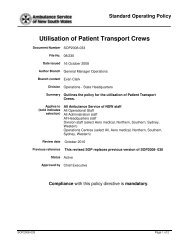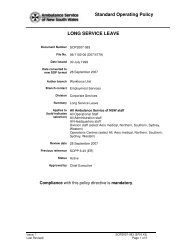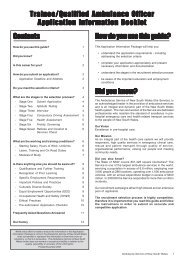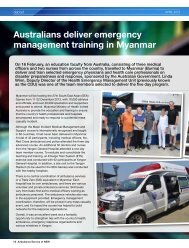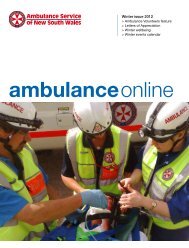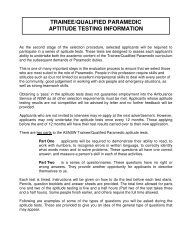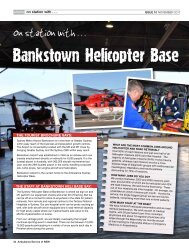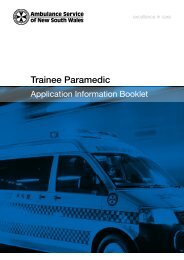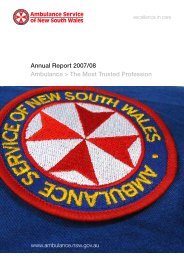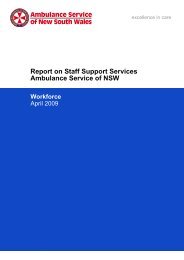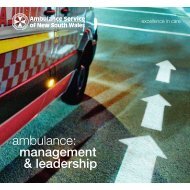atsb final report released 16 may 2013 - Ambulance Service of NSW
atsb final report released 16 may 2013 - Ambulance Service of NSW
atsb final report released 16 may 2013 - Ambulance Service of NSW
You also want an ePaper? Increase the reach of your titles
YUMPU automatically turns print PDFs into web optimized ePapers that Google loves.
The surgeon concluded that the cause <strong>of</strong> death was hypovolaemic shock (bloodloss) secondary to internal bleeding due to fractures <strong>of</strong> the pelvis and that theinjuries were consistent with a fall from height. Based on these injuries, the surgeonconcluded that:...the only prospects <strong>of</strong> survival for the deceased would have been institutingdefinitive medical care at a major trauma centre within approximately60 minutes from the time <strong>of</strong> injury. It should be noted that even if the patientwas able to be evacuated to a major trauma centre within this time-frame,there would still be a moderate to high risk <strong>of</strong> death from injuries <strong>of</strong> thisseverity.A supplementary assessment <strong>of</strong> the injuries sustained by the duty paramedic wasundertaken by the surgeon using the Injury Severity Score (ISS) 20 . This assessmentidentified a high to very high risk <strong>of</strong> death, even with definitive medical treatmentavailable. The surgeon advised that use <strong>of</strong> the available medical equipment andexpertise at the site <strong>may</strong> have extended the timeframe before having to commencedefinitive medical care at a trauma centre by no more than about 4 hours.In respect <strong>of</strong> the potential adverse effects <strong>of</strong> winching the injured paramedic in aharness, the surgeon stated that:It is well known that internal bleeding as a result <strong>of</strong> severe and unstable pelvicfractures <strong>may</strong> be worsened by movement <strong>of</strong> the fracture site. In this way, it ispossible that the deceased’s injuries <strong>may</strong> have been aggravated by winchingin a harness. The correct method <strong>of</strong> extrication <strong>of</strong> a patient sustaining unstablefractures <strong>of</strong> the pelvis such as that sustained by the deceased is with thepatient lying supine (flat on their back) on a spinal board or within a rigidlitter, and with the pelvis supported by a pelvic binder. This is in order toreduce movement <strong>of</strong> the fracture site that could accelerate any internalbleeding from the injury.Toxicological analysis detected a ‘clinically insignificant’ level <strong>of</strong> alcohol in theparamedic’s blood. The examining pathologist concluded this was most likely dueto natural post-mortem generation <strong>of</strong> alcohol rather than the result <strong>of</strong> consumption.The injured canyoner’s most significant injury was a fractured lumbar vertebra.Organisational and management informationHelicopter operatorThe helicopter operator was contracted to provide emergency medical rotary wingtransport services in the greater Sydney area for the AS<strong>NSW</strong>. Specifically theoperator provided the helicopters, pilots, air crewman (ACM) and maintenancepersonnel as well as training for AS<strong>NSW</strong> paramedics in their role as ambulancerescue crewmen.The contract required an AW139 helicopter and a Eurocopter EC145 helicopter tobe based at Bankstown, with a second AW139 at Wollongong and a secondEC145 at Orange. At the time <strong>of</strong> the accident the EC145 helicopter at Bankstown20The Injury Severity Score (ISS) is an anatomical scoring system that provides an overall score forpatients with multiple injuries.- 27 -



